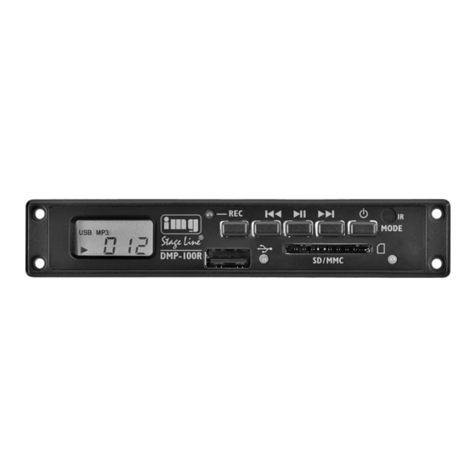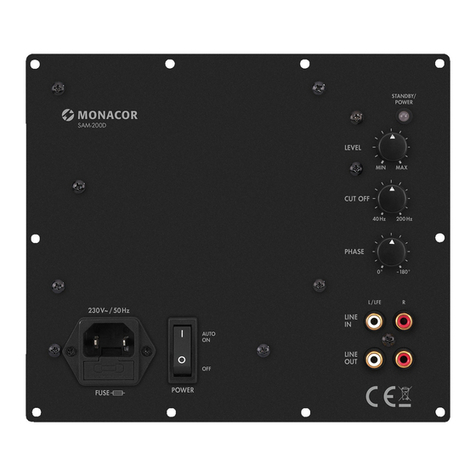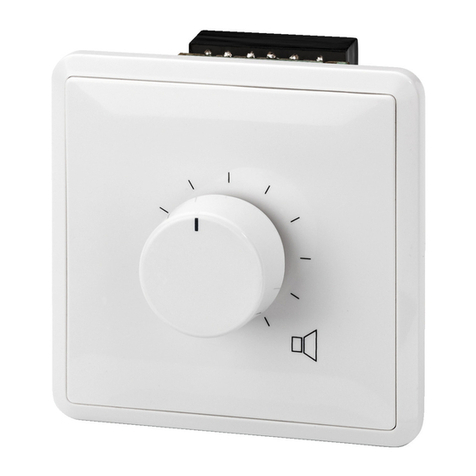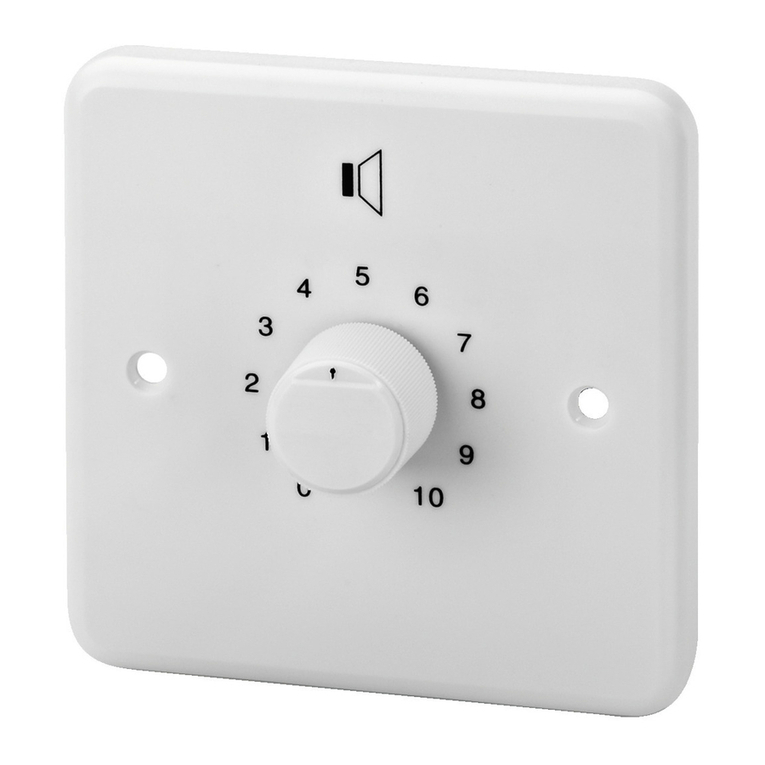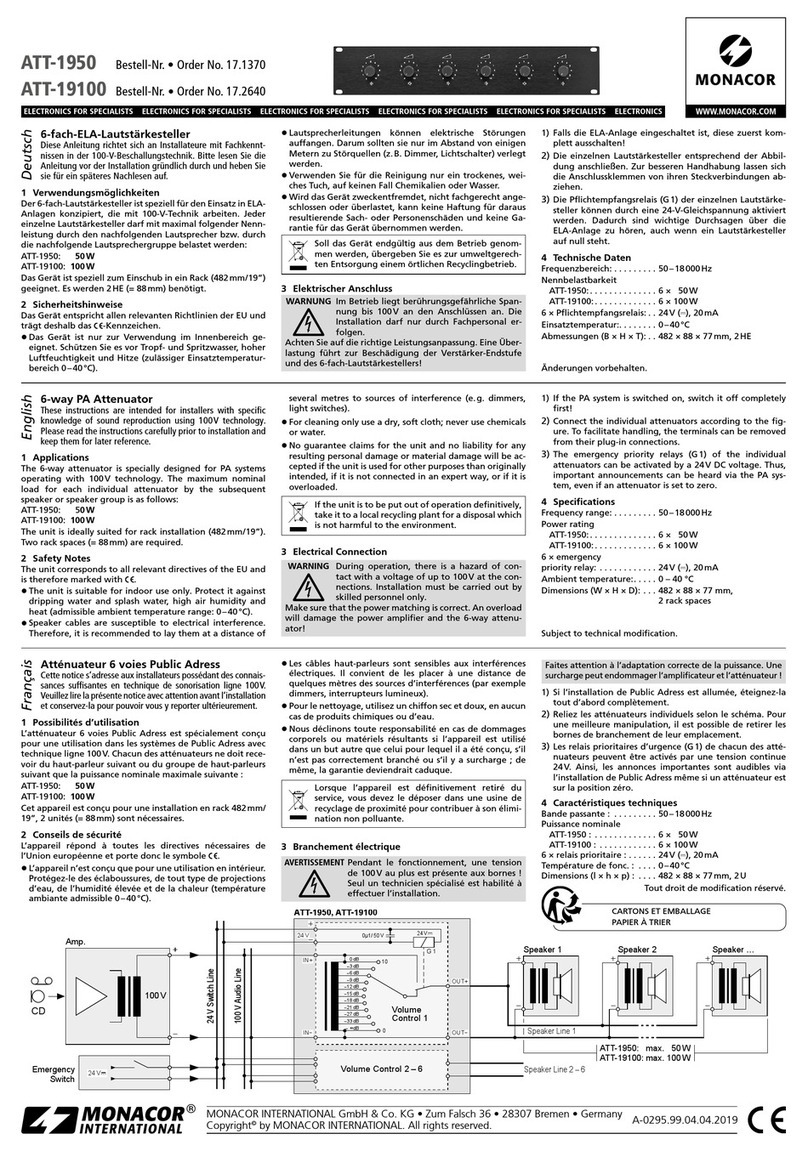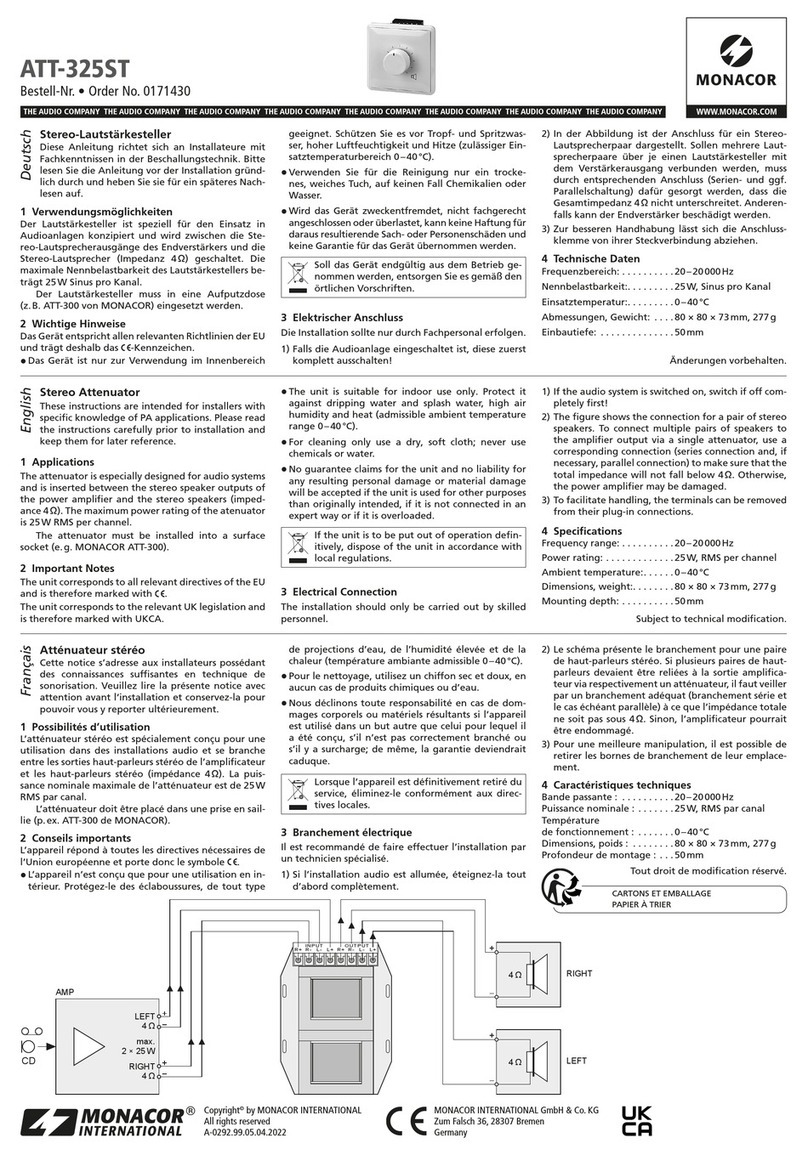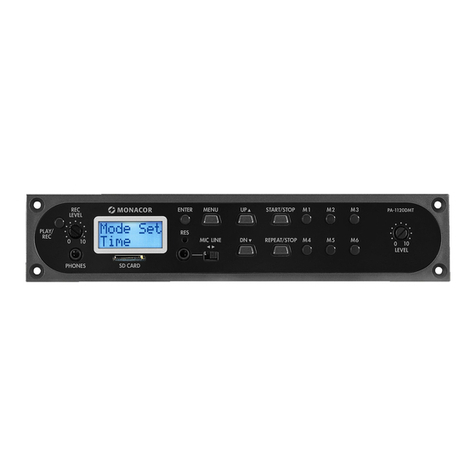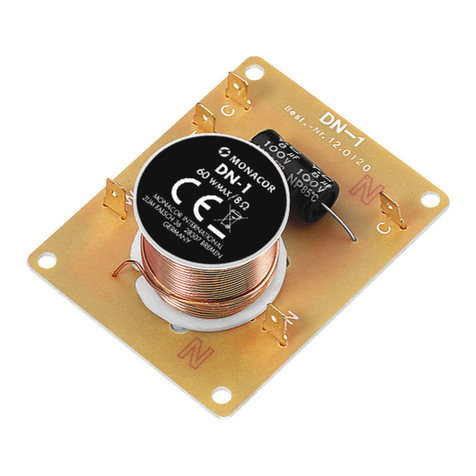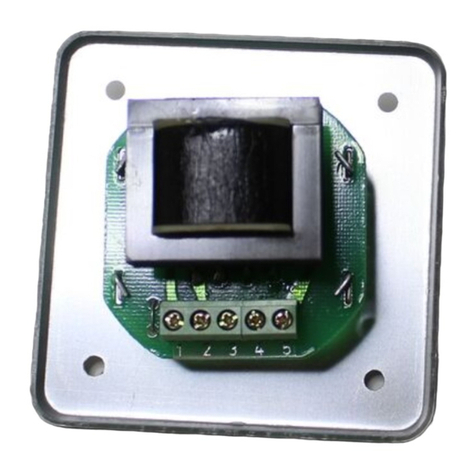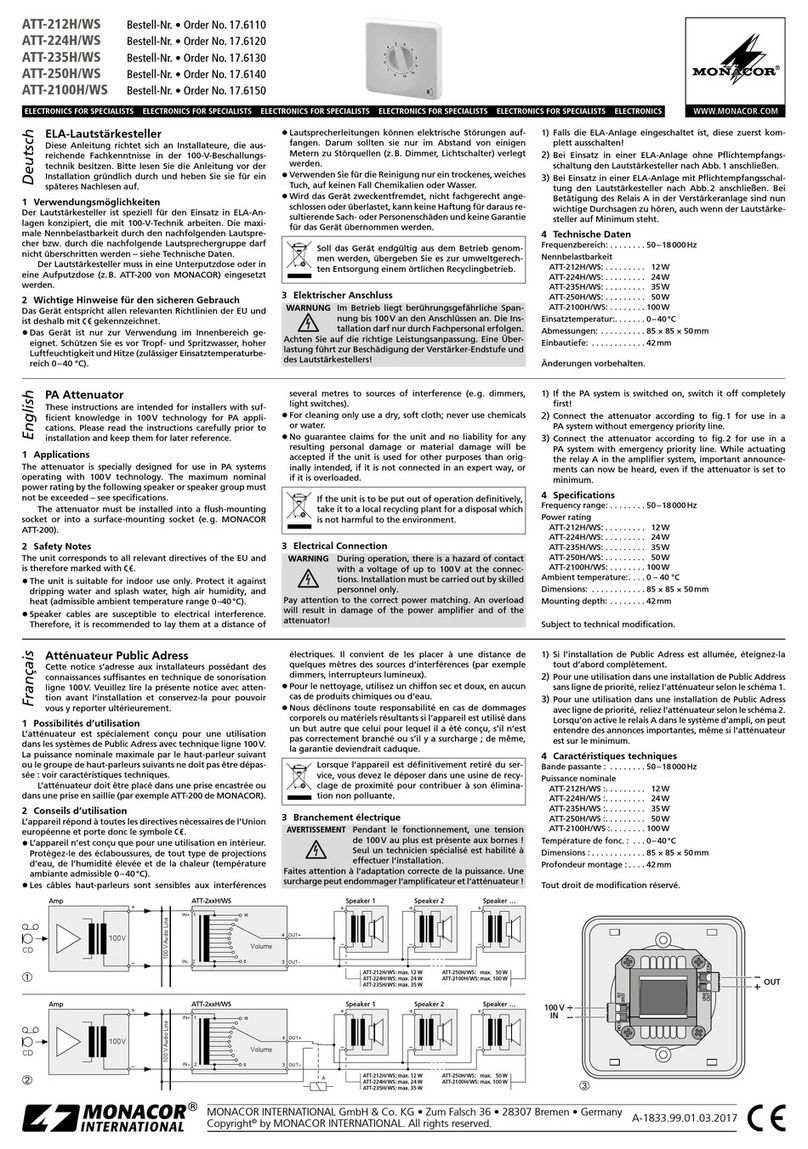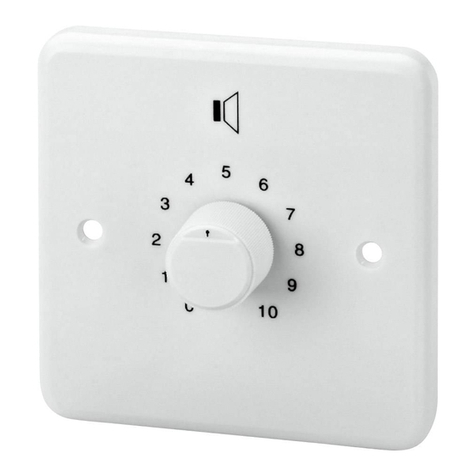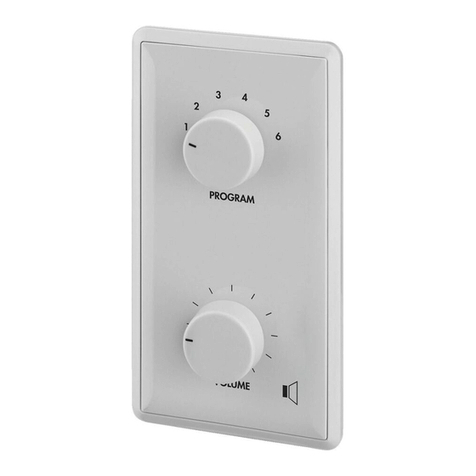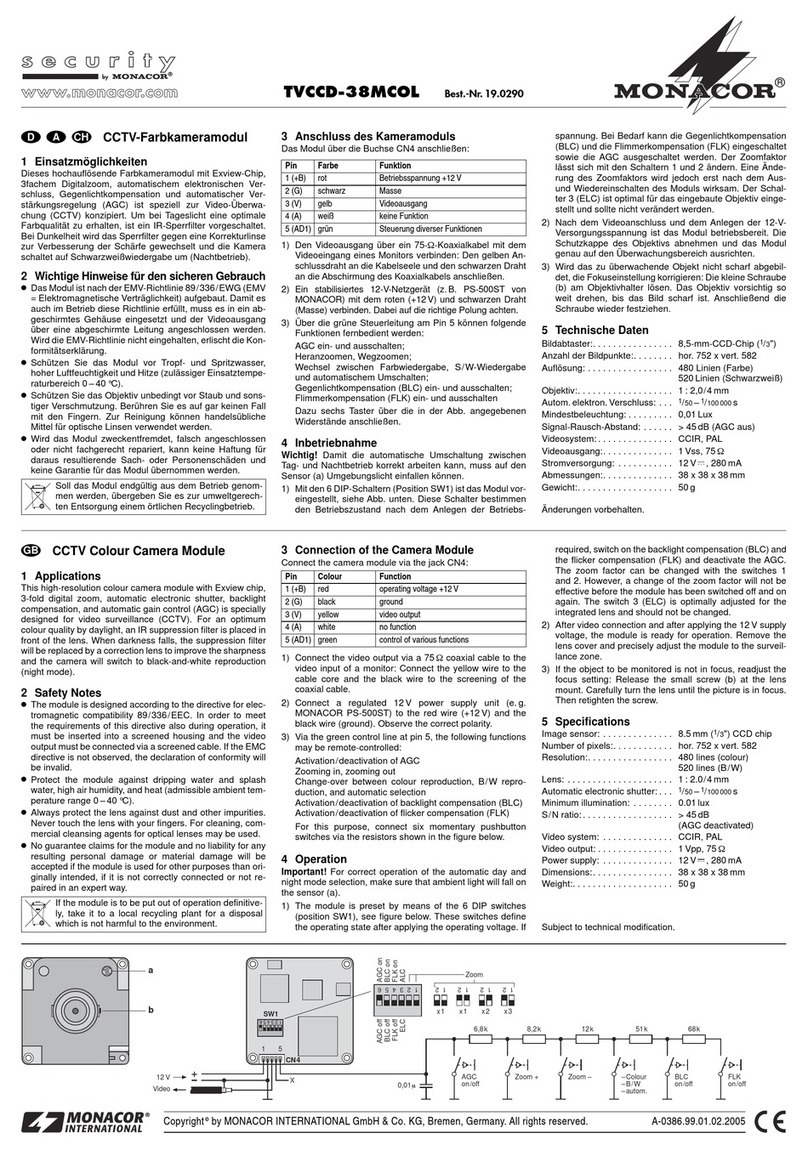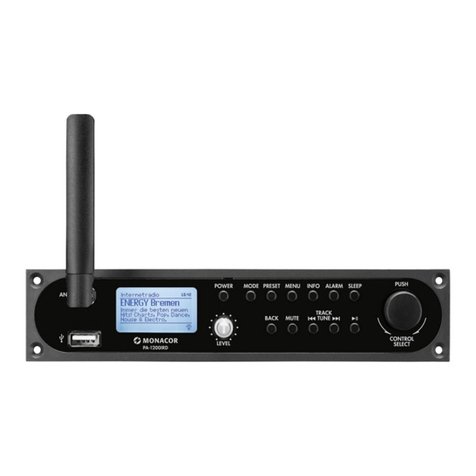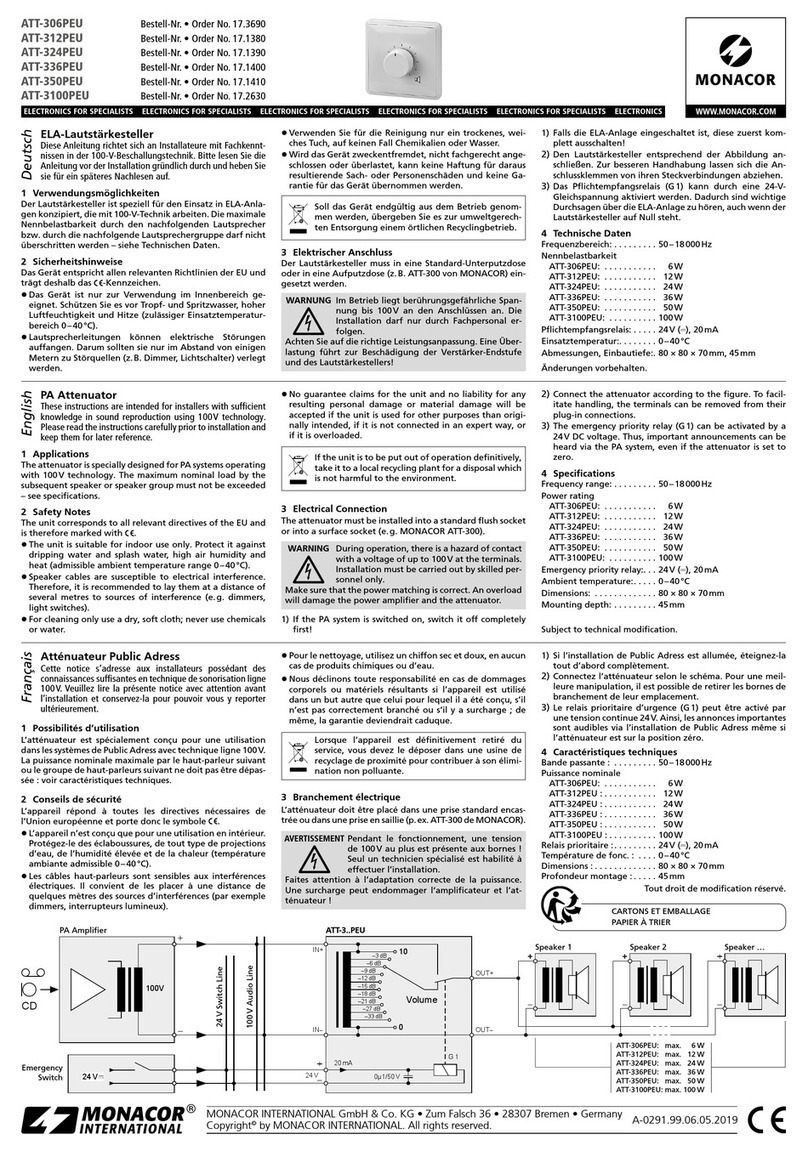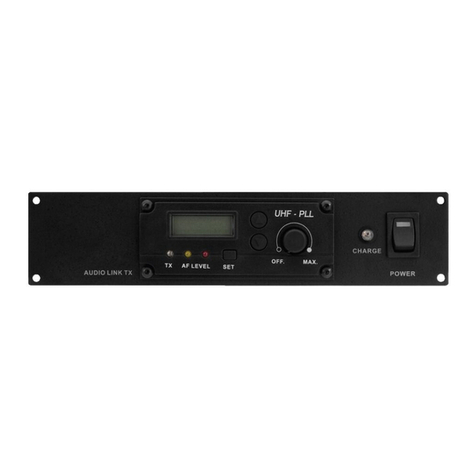
ELECTRONICS FOR SPECIALISTS ELECTRONICS FOR SPECIALISTS ELECTRONICS FOR SPECIALISTS ELECTRONICS FOR SPECIALISTS ELECTRONICS FOR SPECIALISTS ELECTRONICS
MONACOR INTERNATIONAL GmbH & Co. KG • Zum Falsch 36 • 28307 Bremen • Germany
Copyright©by MONACOR INTERNATIONAL. All rights reserved. A-0989.99.04.03.2017
MPA-1
Réferénce num. • Codice 32.0550
C 3
470 p
C 1
22 µ
INPUT
OUTPUT
C 2
100 µ
R 6
150
VR 1
10 k
R 5
10 k
R 3
100
R 4
221 k
R 2
56 k2
R 1
100 k
IC 1
TL 071
7
4
6
2
3
R 7
681
R 8
22 k1
5
1
8
R 9
1k
R 10
47 k5
D 1
BZX55C10
C 4
22 µ
R 11
4 k75
TR 1
BC 549
D 2
BZX55C15
TR 2
TIP 122
R 12
27 k4
C 6
10 µ
+U 12 – 40 V
C 5
100 µ
9 V
C7
330n
C7
330n
➁
➀
Input Output TR 2
VR 1
IC 1
1 4
8 5 +U
MONACOR MPA-1
C 2
Modulo preamplificatore
permicrofono
Queste istruzioni sono rivolte all’utente con cono-
scenze base elettroniche� Vi preghiamo di leggerle
attentamente prima dell’installazione e di conser-
varle per un uso futuro�
1 Possibilità d’impiego
Il modulo MPA-1 permette di collegare un microfono
con l’ingresso Line di un apparecchio audio. Il mo-
dulo può funzionare, insieme ad un alimentatore de
rete, come unità singola, oppure può essere montato
in un apparecchio audio (p.es. amplificatore, mixer
ecc.). Come alimentazione occorre una tensione con-
tinua di 12–40 V; l’assorbimento è di 6 mA.
2 Avvisi importanti per l’uso
Il modulo è conforme a tutte le direttive rilevanti
dell’UE e pertanto porta la sigla
•
Questomodulocorrispondealladirettiva2014/30/UE
sulla compatibilità elettromagnetica CEM. Per
rispettare tali criteri anche durante il funziona-
mento, il modulo deve essere inserito in un con-
tenitore schermato, e l’ingresso e l’uscita devono
essere collegati con cavi schermati. Se non si
rispetta la direttiva CEM, la dichiarazione di confor-
mità perde il suo valore.
•
Far funzionare il modulo solo all’interno di locali.
Proteggerlo dall’acqua gocciolante e dagli spruzzi
d’acqua, da alta umidità dell’aria e dal calore (tem-
peratura d’impiego ammessa fra 0 e 40°C).
•
Nel caso d’uso improprio, di collegamento sba-
gliato, di sovraccarico o di riparazione non a
regola d’arte del modulo, non si assume nessuna
responsabilità per eventuali danni consequenziali a
persone o a cose e non si assume nessuna garanzia
per il modulo.
Se si desidera eliminare il modulo definitiva-
mente, consegnarlo per lo smaltimento ad
un’istituzione locale per il riciclaggio.
3 Collegamento
La figura 1 illustra tutti i collegamenti:
INPUT ingresso segnale, da collegare con
ilmicrofono
⊥massa del microfono
OUTPUT uscita
⊥massa dell’uscita
+U tensione d’esercizio 12–40 V (⎓)
⊥massa della tensione d’esercizio
4 Messa in funzione
Dopo aver applicata la tensione d’alimentazione, il
preamplificatore per microfono è pronto per l’uso.
Con il regolatore del modulo si può impostare il
volume del microfono, faccendo attenzione a non
sovrapilotare l’apparecchio a valle.
5 Dati tecnici
Banda passante: � � � � � � � � � �20 – 15 000 Hz, −0,5 dB
15 – 20 000 Hz, −3,0 dB
Sensibilità d’ingresso: � � � � � �2 mV con 0 dB all’uscita
Impedenza d’ingresso: � � � � � �200 Ω – 10 kΩ
Tensione d’uscita: � � � � � � � � �7V max�/1 kΩ
Amplificazione: � � � � � � � � � � �52 dB
Rapporto S/R: � � � � � � � � � � � �> 65 dB
Fattore di distorsione: � � � � � �< 0,05 %
Tensione di rumore: � � � � � � � �0,5 µV
Alimentazione: � � � � � � � � � � �12 – 40 V (⎓)/6 mA
Temperatura d’impiego
ammessa: � � � � � � � � � � � � � � �0 – 40 °C
Dimensioni
senza asse (l × h × p):� � � � � �40 × 25 × 60 mm
Peso:� � � � � � � � � � � � � � � � � � �30 g
Con riserva di modifiche tecniche.
Module préamplificateur
pourmicrophone
Cette notice s’adresse aux utilisateurs avec connais-
sance de base eléctroniques�Veuillez lire la présente
notice avec attention avant le fonctionnement et
conservez-la pour pouvoir vous y reporter ultérieu-
rement�
1 Possibilités d’utilisation
Le module MPA-1 permet de brancher un micro-
phone à une entrée Line d’un appareil audio. Avec
une alimentation correspondante, le préamplificateur
peut fonctionner comme appareil individuel ou être
inséré comme module dans un appareil audio (par
exemple, amplificateur, table de mixage ...). Une ali-
mentation DC de 12–40 V est nécessaire, la consom-
mation est de 6mA.
2 Conseils importants d’utilisation
Le module répond à toutes les directives nécessaires
de l’Union européenne et porte donc le symbole .
•
Le module répond à la directive 2014/30/UE re-
lative à la compatibilité électromagnétique. Pour
qu’il réponde à cette directive pendant le fonction-
nement, l’appareil doit être placé dans un boîtier
blindé, l’entrée et la sortie doivent être reliées
par des câbles blindés. En cas de non respect de
cette directive, l’appareil ne saurait être reconnu
conforme.
•
Le module n’est conçu que pour une utilisation en
intérieur. Protégez-le des éclaboussures, de tout type
de projections d’eau, d’une humidité élevée et de la
chaleur (température ambiante admissible 0–40 °C).
•
Nous déclinons toute responsabilité en cas de
dommages corporels ou matériels résultants si le
module est utilisé dans un but autre que celui pour
lequel il a été conçu, s’il n’est pas correctement
branché, s’il y a surcharge ou s’il n’est pas réparé
par une personne habilitée ; en outre, la garantie
deviendrait caduque.
Lorsque le module est définitivement retiré
du service, vous devez le déposer dans une
usine de recyclage de proximité pour contri-
buer à son élimination non polluante.
CARTONS ET EMBALLAGE
PAPIER À TRIER
3 Branchements
Le schéma 1 présente tous les branchements à
effectuer :
INPUT
entrée du signal, branchement pour le micro
⊥masse pour le micro
OUTPUT sortie
⊥masse pour la sortie
+U tension de fonctionnement 12– 40V (⎓)
⊥masse pour la tension de fonctionnement
4 Mise en service
Une fois le préamplificateur mis sous tension, il est
prêt à fonctionner. Utilisez le réglage pour adapter
le volume du microphone ; veillez à éviter toute sur-
charge de l’appareil suivant.
5 Caractéristiques techniques
Bande passante :� � � � � � � � � �20 – 15 000 Hz, −0,5 dB
15 – 20 000 Hz, −3,0 dB
Sensibilité d’entrée : � � � � � � �2 mV à 0 dB en sortie
Impédance d’entrée :� � � � � � �200 Ω – 10 kΩ
Tension de sortie : � � � � � � � � �7V max�/1 kΩ
Amplification :� � � � � � � � � � � �52 dB
Rapport signal/bruit :� � � � � � �> 65 dB
Taux de distorsion : � � � � � � � �< 0,05 %
Tension de ronflement : � � � � �0,5 µV
Alimentation : � � � � � � � � � � � �12 – 40 V (⎓)/6 mA
Température autorisée de
fonctionnement : � � � � � � � � � �0 – 40 °C
Dimensions
sans axe (L × H × P) : � � � � � �40 × 25 × 60 mm
Poids :� � � � � � � � � � � � � � � � � �30 g
Tout droit de modification réservé.
FrançaisItaliano
